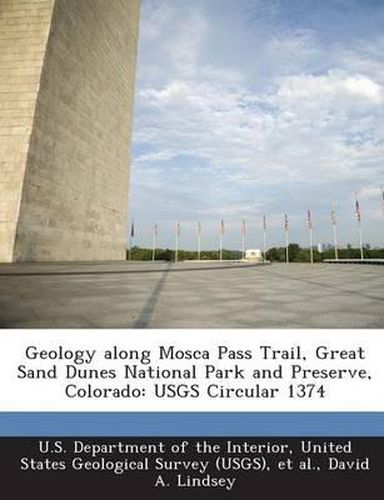Readings Newsletter
Become a Readings Member to make your shopping experience even easier.
Sign in or sign up for free!
You’re not far away from qualifying for FREE standard shipping within Australia
You’ve qualified for FREE standard shipping within Australia
The cart is loading…






Mosca Pass Trail takes the hiker on a journey into the Earth’s crust. Here you can see the results of tremendous tectonic forces that bend and tear rocks apart and raise mountain ranges. The trail begins near the Sangre de Cristo fault, which separates the Sangre de Cristo Range from the San Luis Valley. The valley is part of the Rio Grande rift, a series of fault basins extending from southern New Mexico to central Colorado, wherein the Earth’s crust has been pulled apart during the last 30 million years. Thousands of feet of sediment, brought by streams mostly from the Sangre de Cristo Range, fill the San Luis Valley beneath the Great Sand Dunes. The trail ends at Mosca Pass overlooking Huerfano Park. The park is part of the larger Raton Basin, formed by compression of the Earth’s crust during the Laramide orogeny, which occurred 70-40 million years ago. Massive highlands, the remnants of which are preserved in the Sangre de Cristo Range, were uplifted and pushed over the western side of the Raton Basin. Streams eroded the highland as it rose and filled the Raton Basin with sediment. After the sediment was compacted and cemented to form sedimentary rock, the Huerfano River and other streams began to excavate the basin. Over an unknown but long timespan that probably lasted millions of years, relatively soft sedimentary rocks were removed by the river to form the valley we call “Huerfano Park.” Between the ends of the trail, the hiker walks through an erosional “window,” or opening, into red sedimentary rocks overridden by gneiss, a metamorphic rock, during the Laramide orogeny. This window gives the hiker a glimpse into the Laramide highland of 70-40 million years ago that preceded the present-day Sangre de Cristo Range. The window is the focus of this trail guide.
$9.00 standard shipping within Australia
FREE standard shipping within Australia for orders over $100.00
Express & International shipping calculated at checkout
Mosca Pass Trail takes the hiker on a journey into the Earth’s crust. Here you can see the results of tremendous tectonic forces that bend and tear rocks apart and raise mountain ranges. The trail begins near the Sangre de Cristo fault, which separates the Sangre de Cristo Range from the San Luis Valley. The valley is part of the Rio Grande rift, a series of fault basins extending from southern New Mexico to central Colorado, wherein the Earth’s crust has been pulled apart during the last 30 million years. Thousands of feet of sediment, brought by streams mostly from the Sangre de Cristo Range, fill the San Luis Valley beneath the Great Sand Dunes. The trail ends at Mosca Pass overlooking Huerfano Park. The park is part of the larger Raton Basin, formed by compression of the Earth’s crust during the Laramide orogeny, which occurred 70-40 million years ago. Massive highlands, the remnants of which are preserved in the Sangre de Cristo Range, were uplifted and pushed over the western side of the Raton Basin. Streams eroded the highland as it rose and filled the Raton Basin with sediment. After the sediment was compacted and cemented to form sedimentary rock, the Huerfano River and other streams began to excavate the basin. Over an unknown but long timespan that probably lasted millions of years, relatively soft sedimentary rocks were removed by the river to form the valley we call “Huerfano Park.” Between the ends of the trail, the hiker walks through an erosional “window,” or opening, into red sedimentary rocks overridden by gneiss, a metamorphic rock, during the Laramide orogeny. This window gives the hiker a glimpse into the Laramide highland of 70-40 million years ago that preceded the present-day Sangre de Cristo Range. The window is the focus of this trail guide.